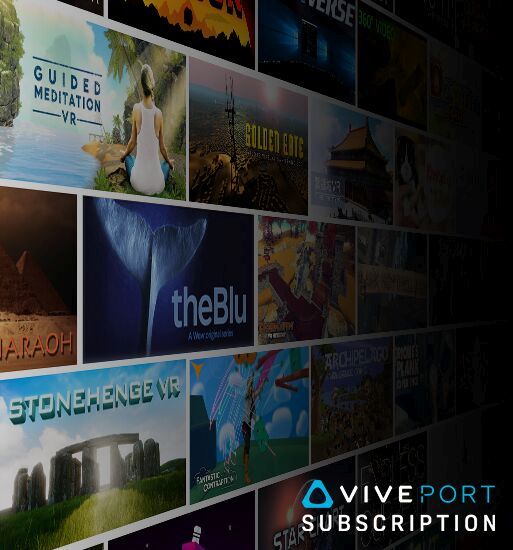While millions of VR headsets are in the hands of consumers, there’s fragmentation between mobile VR, PlayStation VR, and PC VR adoption, even though many VR titles are platform agnostic. Growth in the VR market has been less than many analysts first predicted, and we’ve yet to see a “killer app” emerge as the market continues to expand. However, we’ve seen some early successes, such as the Survios game Raw Data which has generated more than $1 million, and Owlchemy’s Job Simulator which has generated more than $3 million in revenue. At the same time, hardware sales have been close a million units for PlayStation VR, and analysts estimate less than a million for Oculus Rift and HTC Vive combined (with Vive a clear leader), while Samsung’s Gear VR has around 5 million units installed.
We’re still far from a large-scale VR market that can generate billions in software revenues, but HTC Vive is working on a variety of ways to get to that point. The one-year anniversary of HTC Vive showed a market that’s small but growing. To further accelerate that growth, HTC introduced the the Viveport Subscription service.
HTC Vive launched Viveport Subscription on April 5, celebrating the first anniversary of the HTC Vive by introducing the first-ever subscription model for a VR app store. Viveport Subscription customers pay $6.99 a month and choose five titles from an ever-growing library of curated content. Users get unlimited access to those apps and they can rotate out their selection every month. All apps in the subscription service are also available for sale, letting customers try an app before they decide to buy. Viveport Subscription includes a one month free trial offer for all new users.
“We’re surprised every day by what our fans and developers have brought to VIVE in its first year,” said Daniel O’ Brien, GM US, HTC Vive. “We’re astounded by the impact that VR is making in the home and in the enterprise, and we want to celebrate Vive’s first birthday by giving a bit back to our fans and by introducing Vive to more people.”

Rahul Sandil, vice president of marketing at HTC Vive, sat down with AListDaily for a wide-ranging talk about Vive and where VR is going from here.
The first issue that Sandil wanted to establish was HTC Vive’s goal as it expanded the VR market. “What helps us build more trust with developers and consumers? We weigh both those things together,” said Sandil. “We believe the subscription is a great way to do this for developers and consumers. For developers, it’s a whole new business model—they can bring their content and get access to the Vive and Viveport audience. It’s another way to monetize apps for them. One of the missions of Viveport is to give developers the most ways to monetize their content.”
Sandil then described the Viveport Subscription model. “Consumers pay a low monthly price, in the US that’s $6.99, and consumers can pick five apps every month, and once the month is over they can swap those out for five new ones, or keep any the want to keep playing,” Sandil explained. “We believe it’s a great opportunity for consumers to try before you buy.” Sandil noted that the average price of a VR app is somewhere between $10 and $15, and thus paying around half of that average for access to five apps is a great deal. It’s also an easy, low-risk way for people to try out more apps to find ones they might want to buy.
“The VR ecosystem is still very young and growing. We are coming up on almost 300 apps on Viveport, of which half of them are free and the other half are paid,” Sandil said. “In Viveport Global, which includes China, we have already crossed 650 apps, probably half are free and half are paid.”
With an increasing number of apps, it’s becoming ever more difficult for customers to find the apps they’d prefer. The Viveport Subscription aims to solve that problem. “This is a great way for customers to try the selection,” said Sandil. ” We believe that one of the best ways to grow the VR ecosystem is to have a great selection, and at the same time we want to make it easy for customers to try things and get to try different kinds of VR experiences.”
HTC Vive is concerned about providing a good value not only for consumers, but for developers as well. “It’s not based on usage for developer monetization,” Sandil explained. “We’ve tried to make it simple and fair, both for well known devs and new apps. If you get picked in a month, you will get paid.”
There are a lot of exciting prospects for the VR market in the year ahead. “There will be a lot more innovation on the hardware side—making it untethered, making the hardware more ubiquitous,” Sandil said. “We just launched a deluxe audio strap, better form-fitting, making the experience more comfortable. There will be more comfort, more ways to track your presence in virtual reality.”
But major growth isn’t going to come just from hardware innovation. “We’ve just scratched the surface on content,” Sandil said. “Today, there are over 1,600 apps on Steam and Vive, but I think we’re just getting started. There’s going to be a real multiplication effect on content happening this year. I think this is also going to be the year we’re going to see a lot more AAA content, larger production budgets on VR content. We’ve announced a partnership with Warner for Ready Player One, we’ve got plans to create multiple pieces of content to support that. There’s going to be some really big things happening on the content side.”
Improvements in hardware and more VR software will help expand the market, of course, but Sandil believes the real opportunity lies in business model innovation. “Most importantly is the business models, we’re starting our year two with subscriptions but we believe arcades are going to be that force multiplier, it’s going to bring in audiences who have always been interested in VR but haven’t experienced it yet,” Sandil stated. “I would say there will be a minimum of 10x multiple of people experiencing virtual reality.”


